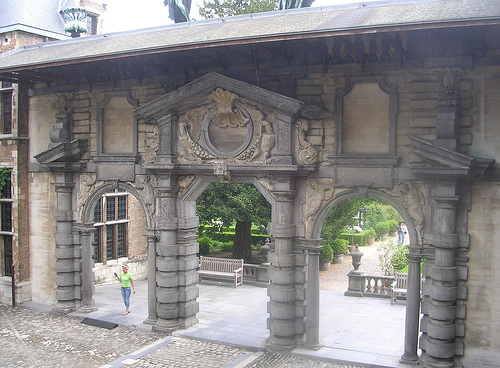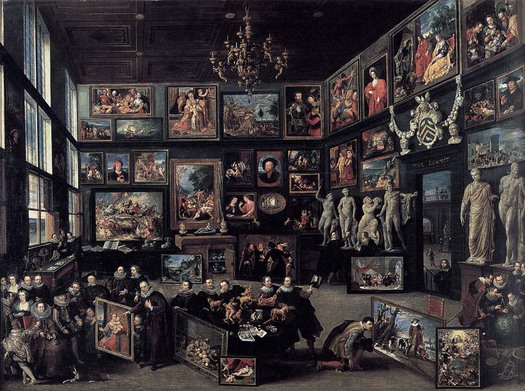
This week, a new exhibition opens at the Rubenshuis in Antwerp dedicated to the painter's work as an architect. Rubens was a man of many talents beyond the profession for which he is best known—among them, he was a gifted statesman, book designer, and antiquarian. Architecture was another field in which he could engage his absurdly grand intellect. Rubens's architectural invention is apparent in many of his paintings. As with his work in that medium, he developed a language that was grand in the fulsome baroque way, with sculptural forms drawn from the classical tradition, but deployed in idiosyncratic fashion. This expression was not restricted to canvas. He designed the facade of an Antwerp cathedral, and most famously built his own home, site of the exhibition, which has been a draw to visitors to the city from the day he opened its doors. In celebration of the show, to follow is an excerpt from my book on Rubens, Master of Shadows, describing the house as it was in his time.
On one of Antwerp’s typically pleasant summer afternoons, with a cool breeze blowing in off the Scheldt and scudding clouds breaking across a crystalline sky, there was no more appealing place to spend a few hours than the lush private garden tucked behind the home of Peter Paul and Isabella Rubens. The painter designed it all, house and garden, having been inspired by the elegant Mantuan homes of the artists Andrea Mantegna and Giulio Romano. His good friend Jan van den Wouvere wrote that he built it expressly to astonish his many distinguished guests.
The property was located on the Wapper, a quiet canal street just off the Meir, Antwerp’s bustling broadway. Rubens purchased it in 1610 from the Harquebusiers Guild for ten thousand guilders, a princely sum. It was a great deal to pay, but the lot came with a handsome house in the traditional Flemish style—three red-brick stories with white stone trim and a steep roof punctured by stepped-gable windows—and an adjacent laundry house that, once demolished, would leave enough room for Rubens to build a new wing facing the street and, in addition, a pair of row houses to rent. In the back, there was space for a large formal garden. It was a good five years before the Rubens family could actually move into their new home, and more than a decade before the artist was finally done tinkering and making alterations. The old Flemish house was gut renovated, and attached to it Rubens built a small Italianate palazzo to serve as his studio and workshop. The style of this building was something new to his neighbors, a precisely crafted jewel of classical design. The sketchbooks Rubens kept during his time in Italy attested to his careful attention to architectural detail. In 1621, he would even publish on this subject: a sumptuous two-volume monograph on the palaces of Genoa that so captivated him on his first visit to that city, years earlier. For the moment, however, Rubens did not build himself a Genovese-style villa. He considered those buildings, though attractive, “suited to housing families of simple gentlefolk.” For his own home, he had something a bit more substantial in mind.
The contrast between Rubens’s two buildings—the older Flemish house that came with the property, and the new Italianate wing he designed himself—was stark, a visual statement of loyalties divided. Inside, however, Rubens characteristically found harmony in the marriage of disparate traditions. Visitors entered through a heavy wooden door in the Flemish side, and from there were led into a courtyard enclosed by a portico that physically and metaphorically united the two wings of the house. Visible beyond was the garden, an Edenic space with a pavilion, fountains, and exotic trees selected especially by the artist. The triple-arched portico, a mash of heavily articulated forms surmounted by statues of Hermes and Athena (the gods associated with diplomacy and the arts), was something entirely of Rubens’s invention, a translation into stone of his artistic and personal philosophy. Its elements, architectural and literary, were drawn from the classical tradition, but applied with the same unique blend of exuberance and bravado Rubens brought to canvas. To that end, satyrs held aloft tablets with inscriptions from Juvenal that warned of life’s fragility and extolled the benefits of humility before the gods.
Rubens advocated humility as a general philosophy, but when it came to architecture he made a distinction between houses that were solid blocks, like the Genovese buildings he recommended for “simple gentlefolk,” and those with open courts at their hearts, like his own, which he considered appropriate for a sovereign prince. Rubens was similarly unafraid to suggest, with a wink and a nudge, a suitably elevated place for his talents in the canon of art history. Across the courtyard façade of the workshop, Rubens recreated in what appeared to be low sculptural relief the works of his esteemed forebears, the most famous painters of Greek history: Zeuxis, Timanthes, Protogenes, Apelles. Their works were known only from literary descriptions, and Rubens suggested it was best they be kept “in imagination alone, like dreams.” Attempts to reproduce them, he wrote, would result only in “something insipid or inconsistent with the grandeur of the ancients…and fail to do justice to those great spirits whom I honor with the profoundest reverence, preferring indeed to admire the traces they have left than to venture to proclaim myself capable of matching them, even in thought alone.” Those words had an appealingly humble ring, but in practice he teasingly violated his own warning.
The frieze running along the workshop facade was actually not a frieze, but a trompe l’oeil depiction of a frieze painted in grisaille, a technique in which monochrome pigment can be used to mimic the effect of stone. This artifice was extended and expanded on the garden façade of the workshop, where a three-dimensional loggia was faked onto what was in fact a blank wall. Above this scene, a painting by Rubens was stretched out to dry, apparently hanging over the “frieze.” Only the drying canvas was not a real drying canvas, but a painting of a drying canvas. The painter’s more erudite friends (and especially the artists who visited) almost certainly appreciated this elaborate inside-joke. The ancient painters Rubens most admired were famous for their ability to fool the eye. The masterpiece of Apelles, the greatest of those artists, was his Calumny, an allegorical rumination on the dangers of bearing false witness. On that front, Rubens had surely proven himself capable of matching his illustrious predecessor. Unfortunately, that subtext was lost on the royal eye of the Infanta Isabella, who asked that Rubens take the drying work down for inspection during one of her visits to the studio.
Inside, the house was furnished and fitted in the best taste, a necessity for entertaining distinguished guests. Royalty from across Europe came to the Rubens house to sit for the painter and to arrange for the purchase of works from his studio. A stop at the elegant home on the Wapper was all but obligatory for dignitaries visiting Antwerp, though travelers did not always arrive at its doors solely with art on their minds. The large formal garden in the back of the house was an excellent place for a private stroll, where delicate political affairs might be addressed away from prying eyes and ears. Moreover, Rubens himself was developing a reputation as a man of insight and discretion, and his proximity to the archdukes Albert and Isabella made him a useful conduit for those wishing to initiate backchannel negotiations with the sovereigns.

The intimacy of his relationship with the archdukes during this time is plainly evident in a painting of a gathering at the Antwerp home of Cornelis van der Geest, one of the artist’s friends. In this picture, painted by William van Haecht in 1615, Albert and Isabella stand just below Rubens’s recently completed Battle of the Amazons, which hangs on a back wall. In the foreground is the painter himself, lecturing the royal couple on the merits of a Quentin Metsys Madonna and Child.
Excerpted from Master of Shadows by Mark Lamster. Copyright © 2009 by Mark Lamster. Excerpted by permission of Nan A. Talese, a division of Random House, Inc. All rights reserved. No part of this excerpt may be reproduced or reprinted without permission in writing from the publisher.
